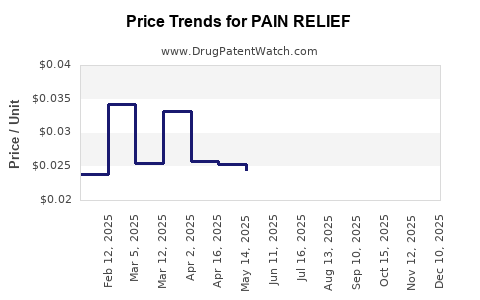Drug Price Trends for PAIN RELIEF
✉ Email this page to a colleague

Average Pharmacy Cost for PAIN RELIEF
| Drug Name | NDC | Price/Unit ($) | Unit | Date |
|---|---|---|---|---|
| PAIN RELIEF 325 MG TABLET | 46122-0390-78 | 0.02207 | EACH | 2024-11-20 |
| PAIN RELIEF 500 MG CAPLET | 00113-0484-85 | 0.03249 | EACH | 2024-11-20 |
| PAIN RELIEF 325 MG TABLET | 46122-0390-78 | 0.02670 | EACH | 2024-10-23 |
| PAIN RELIEF 500 MG CAPLET | 00113-0484-85 | 0.03389 | EACH | 2024-10-23 |
| PAIN RELIEF 500 MG CAPLET | 00113-0484-85 | 0.03669 | EACH | 2024-09-18 |
| PAIN RELIEF 325 MG TABLET | 46122-0390-78 | 0.02568 | EACH | 2024-09-18 |
| >Drug Name | >NDC | >Price/Unit ($) | >Unit | >Date |
Best Wholesale Price for PAIN RELIEF
| Drug Name | Vendor | NDC | Count | Price ($) | Price/Unit ($) | Unit | Dates | Price Type |
|---|---|---|---|---|---|---|---|---|
| PAIN RELIEF ADULT | Geri-Care Pharmaceutical Corp | 57896-0206-08 | 240ML | 2.70 | 0.01125 | ML | 2023-07-01 - 2026-06-14 | FSS |
| PAIN RELIEF ADULT | Geri-Care Pharmaceutical Corp | 57896-0206-08 | 240ML | 2.55 | 0.01063 | ML | 2021-09-18 - 2026-06-14 | FSS |
| >Drug Name | >Vendor | >NDC | >Count | >Price ($) | >Price/Unit ($) | >Unit | >Dates | >Price Type |


